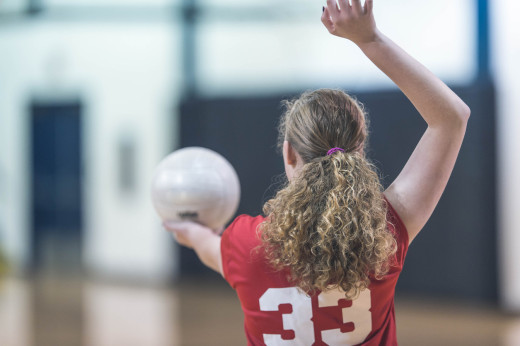- Patient Resources
- Scheduling An Appointment
- Pre-Registering Prior To Your Appointment
- Patient Portal
- Appointment Policies
- Insurance
- Referrals, Workers' Comp & Litigation
- Financial Information
- Preparing For Your Office Visit
- Preparing For Your Surgery or Procedure
- Share Your Medical Images With Andrews Sports Medicine
- Travel & Area Information
- Online Bill Pay
- Financing
- Medical Records
- Prescriptions
- Durable Medical Equipment (DME)
- Injury Prevention
- Purchase Andrews Sports Medicine Gear

Volleyball Injuries
Each year, more than 460,000 high school students — including more than 410,000 girls — participate in interscholastic volleyball. As participation has increased over the past two decades, the number of volleyball-related injuries has risen as well. While volleyball injuries rank lowest for all major sports, volleyball players are at risk for both traumatic and overuse injuries.
What Types of Injuries Are Most Common in Volleyball?
Because volleyball involves repetitive overhead motions, such as spiking and blocking, players are prone to overuse injuries of the shoulder. In addition, volleyball players are particularly susceptible to finger injuries.
How Are Volleyball Injuries Treated?
Rotator Cuff Tendinitis
During serving and spiking, the rotator cuff muscles are important in generating the necessary power to move the shoulder. While rarely completely torn in young players, these muscles can get irritated or fatigued with overuse. Often, rest and physical therapy services may be enough to resolve pain. If pain persists, talk to your physician.
Finger Injuries
Fingers are vulnerable to injury during volleyball activities, such as blocking, setting, and digging. Common finger injuries include fractures, dislocations, and tendon and ligament tears. If you are unable to bend the finger, consultation with your sports medicine professional or athletic trainer is important. Treatment can vary significantly depending on the injury.
Ankle Sprains
Ankle injuries are the most common injury to volleyball players and responsible for the most lost playing time. Ankle sprains should be immobilized for as short as time as possible to allow for quicker rehabilitation. Every ankle sprain needs an 8-week course of daily rehabilitation exercise to decrease the risk of re-injury. Usually injuries can be treated nonoperatively with bracing and physical therapy or home rehabilitation exercises. Occasionally, though, ankle sprains can be associated with subtle fractures or cartilage injuries. Continued pain after several weeks should prompt further evaluation, including X-rays and/or MRIs.
Return to play is usually allowed once players have no pain and are able to support their body weight while standing on the toes. Surgery is reserved for those with recurrent ankle sprains that have not responded to conservative measures or those with specific associated fractures.
Patellar Tendinitis
Patellar tendinitis is inflammation of the tendon that connects the kneecap to the tibia (or shin bone). Patellar tendinitis is common in any athlete subjected to repetitive, forceful jumping activities, such as spiking and blocking.
Patellar tendon straps are helpful in unloading the stress to the patellar tendon and are often the first line of treatment. Physical therapy and athletic training services focused on stretching and strengthening are also helpful. Specific attention to landing from jumping (eccentric contraction of the quadriceps muscles) in rehabilitation is often beneficial. Occasionally, patellar tendinitis persists despite therapy and surgery is required.
Anterior Cruciate Ligament (ACL) Injury
Like ankle sprains, most ACL injuries in volleyball players occur when a player lands awkwardly after jumping.
Usually ACL tears are associated with a “pop” and immediate knee swelling. Examination by a physician and MRI are often used to con rm the ACL injury. Because ACL tears do not heal, those wishing to return to sports activities are encouraged to have the ACL reconstructed. Recovery time is usually at least six to nine months. There are training techniques that may decrease the risk of ACL injury in jumping athletes, especially females. It is important to speak with a qualified athletic trainer or physician before taking part in these activities.
Low-Back Pain
The low back is a common source of chronic pain among volleyball players. The cause of most low-back pain is related to muscle or ligament strain. The pain usually resolves with rest, physical therapy and athletic training services.
If low-back pain is accompanied by pain that radiates down the legs and numbness or weakness in the foot or ankle, the culprit may be a herniated disk. In cases of radiating pain, an MRI may be helpful in evaluating the presence of a disc herniation. In most cases, volleyball players can return to play once the pain, numbness, and weakness resolves.
Volleyball players may also be at increased risk for a sort of stress fracture in the low back called spondylolysis. If pain persists more than a month and is worse with bending backward, consider consulting a physician.
How Can Injury Be Prevented?
Many volleyball injuries can be prevented by following proper training guidelines and these tips:
- Use proper strength training techniques for the lower back, shoulders, and legs
- Use an external ankle support, such as an ankle brace or taping, to prevent the ankle from rolling over, especially if you have had a prior sprain
- Minimize the amount of jump training on hard surfaces • Warm up muscles with stretching and light aerobic exercises
- Be sure to properly cool down after practice
- If you are having pain, visit your doctor and follow instructions for treatment
- The athlete should return to play only when clearance is granted by a health care professional







